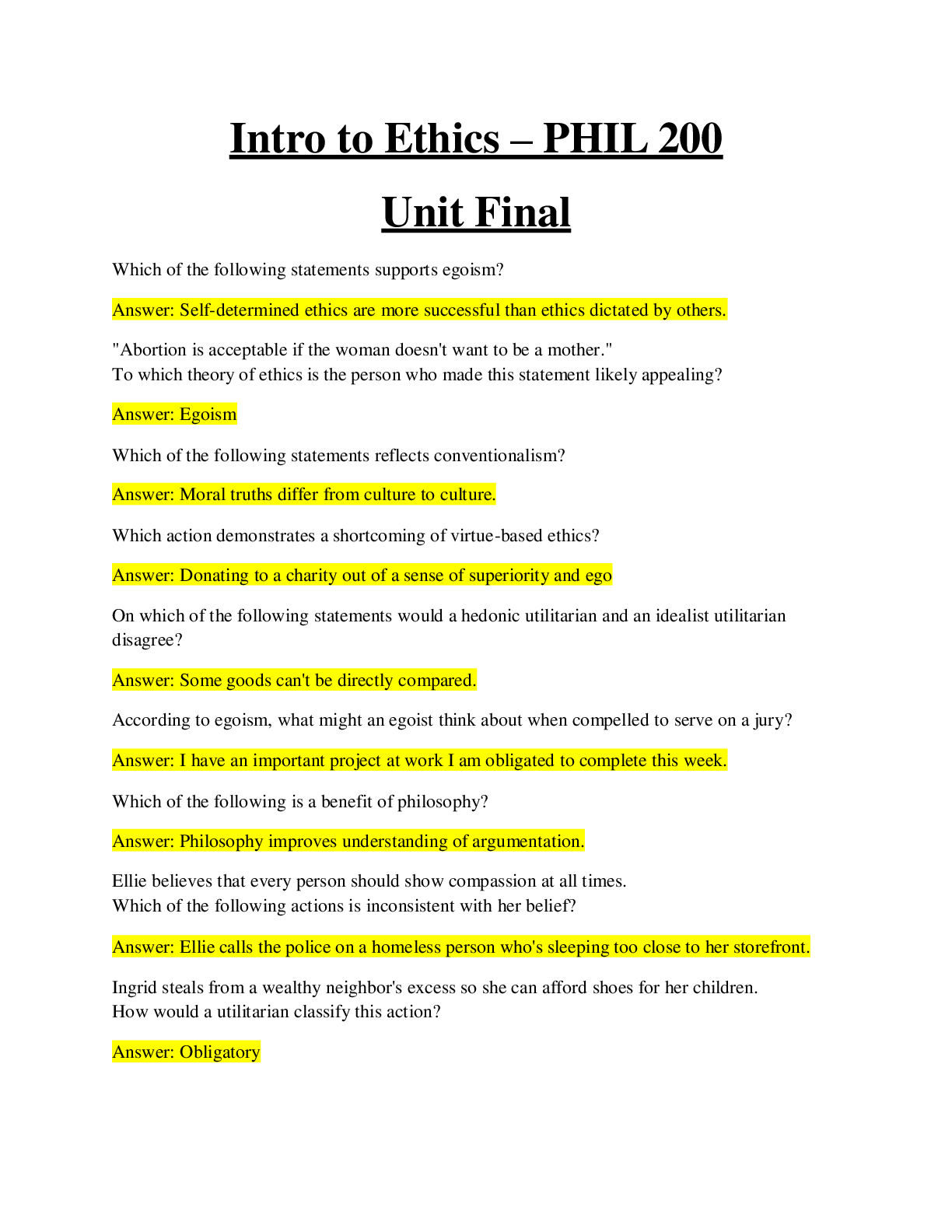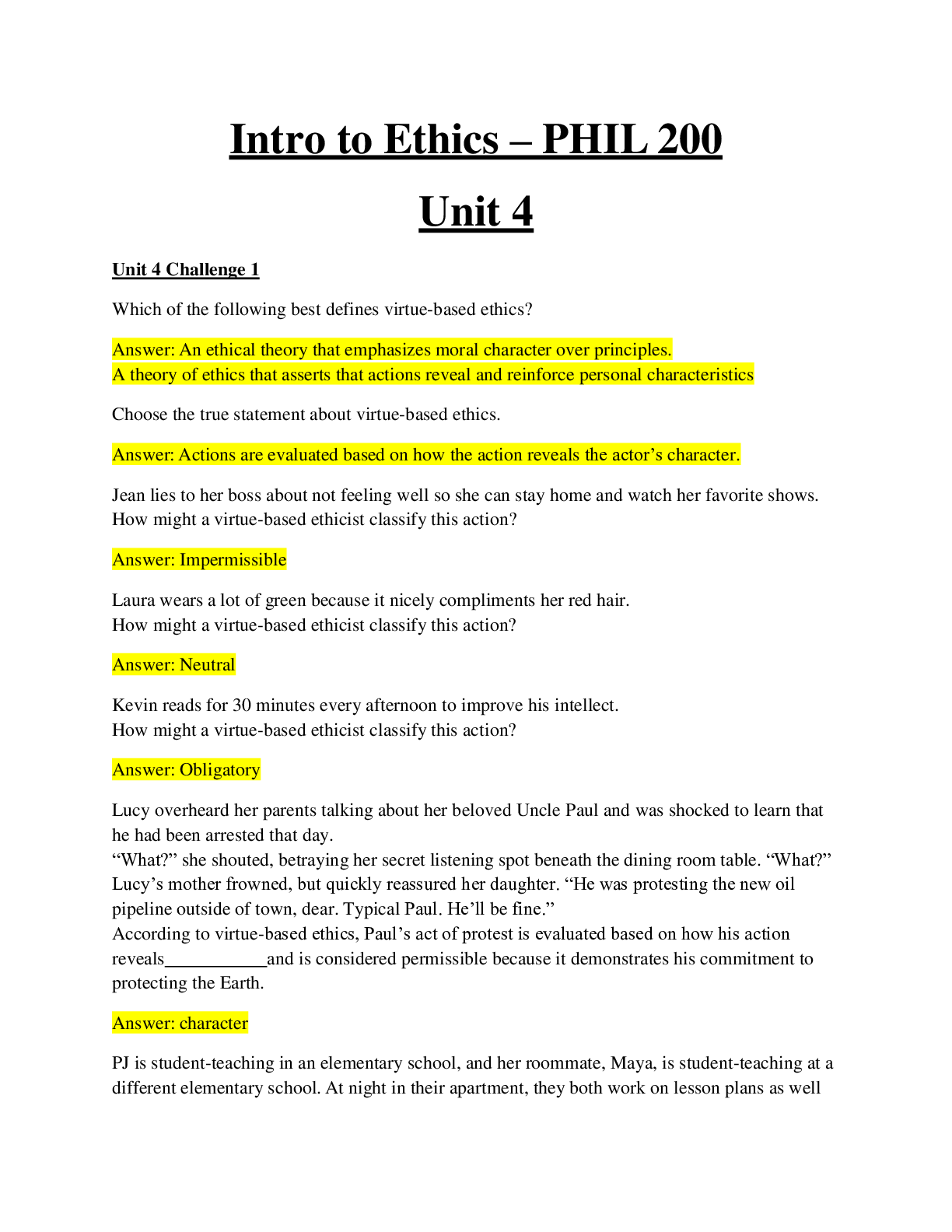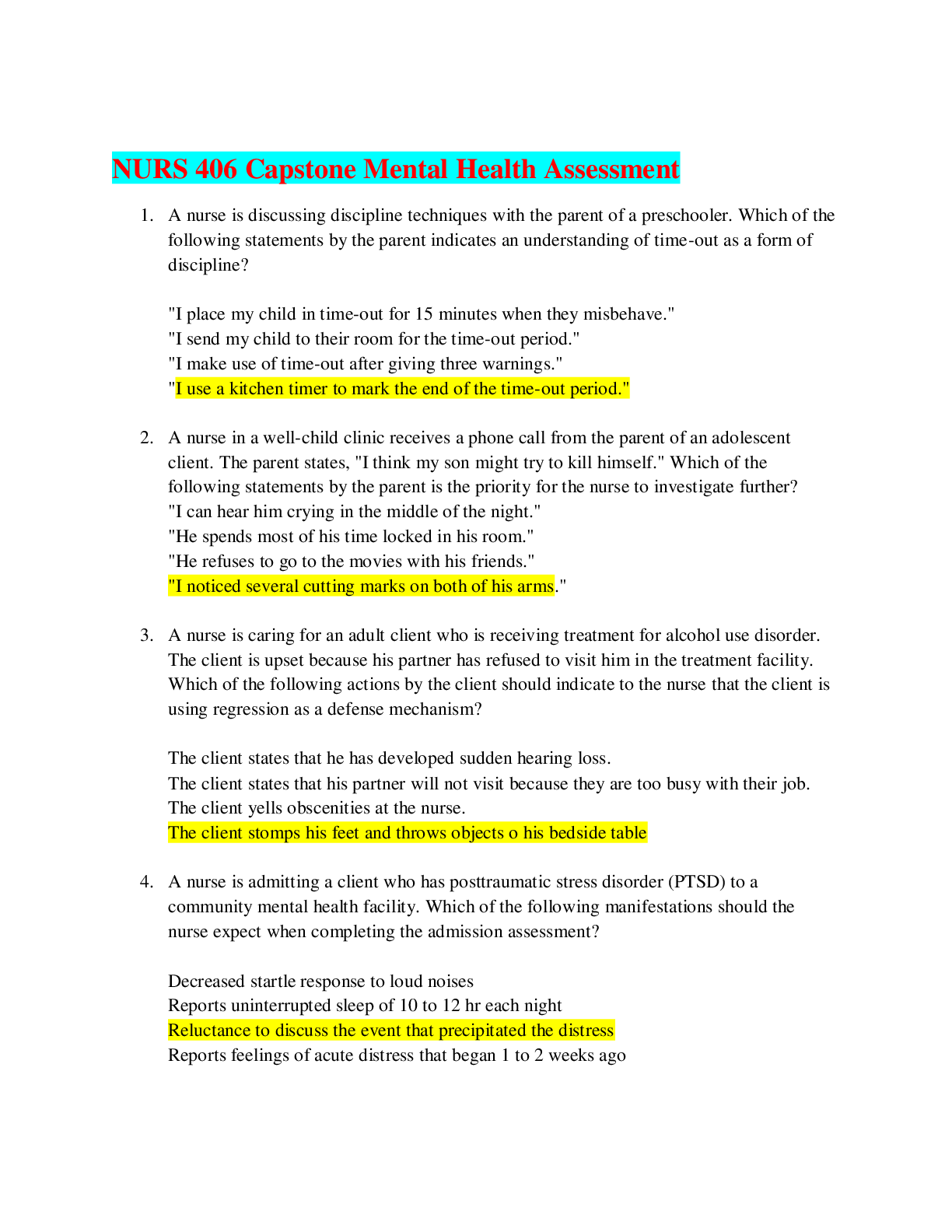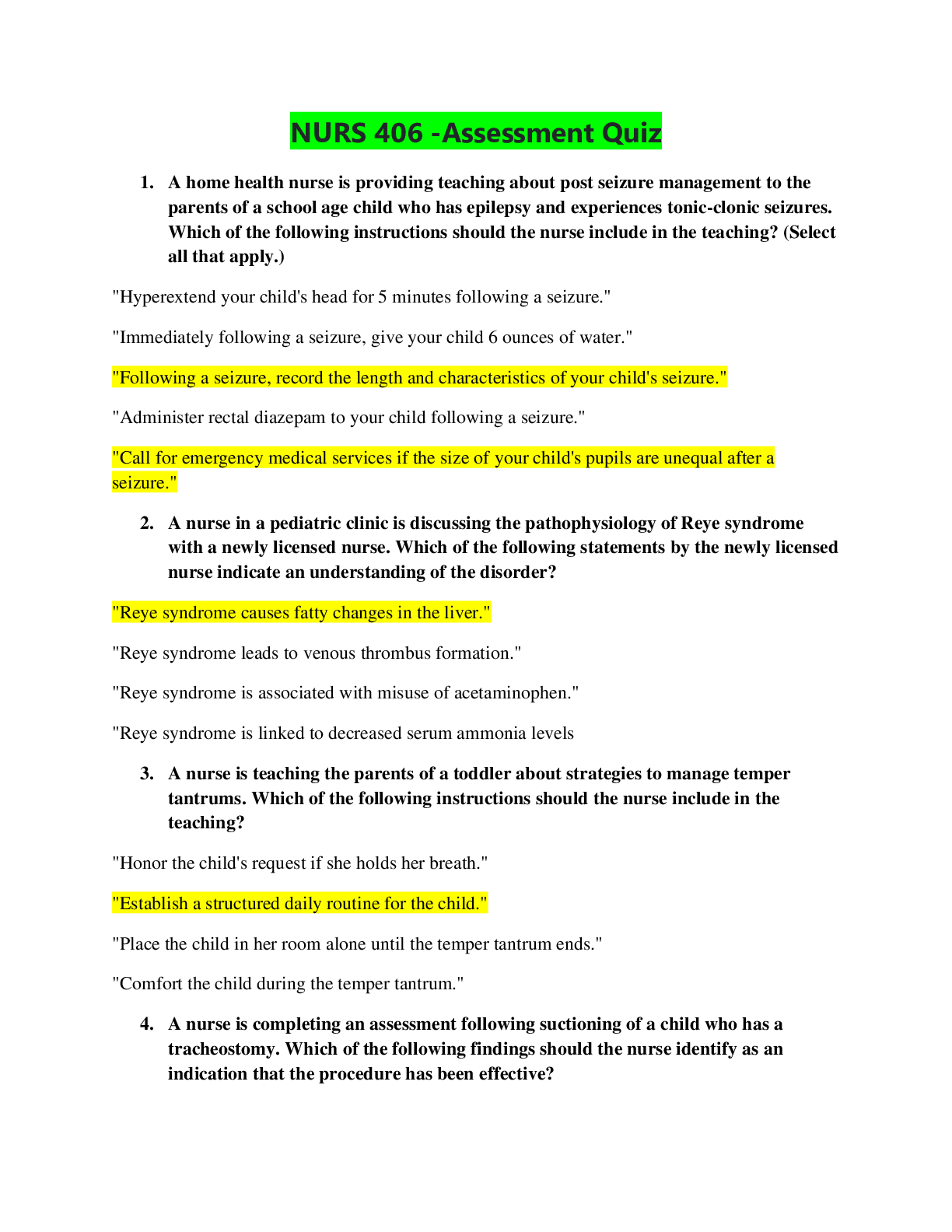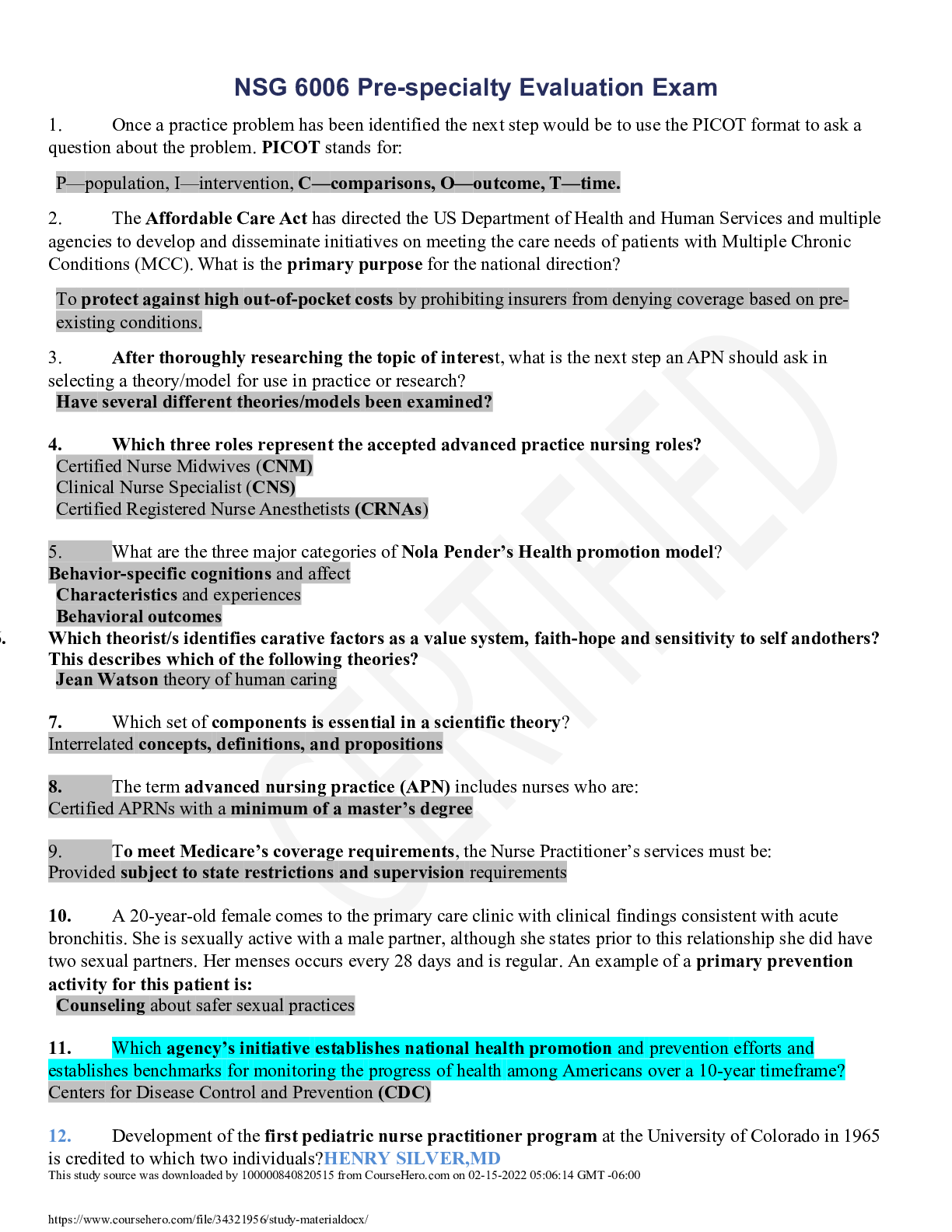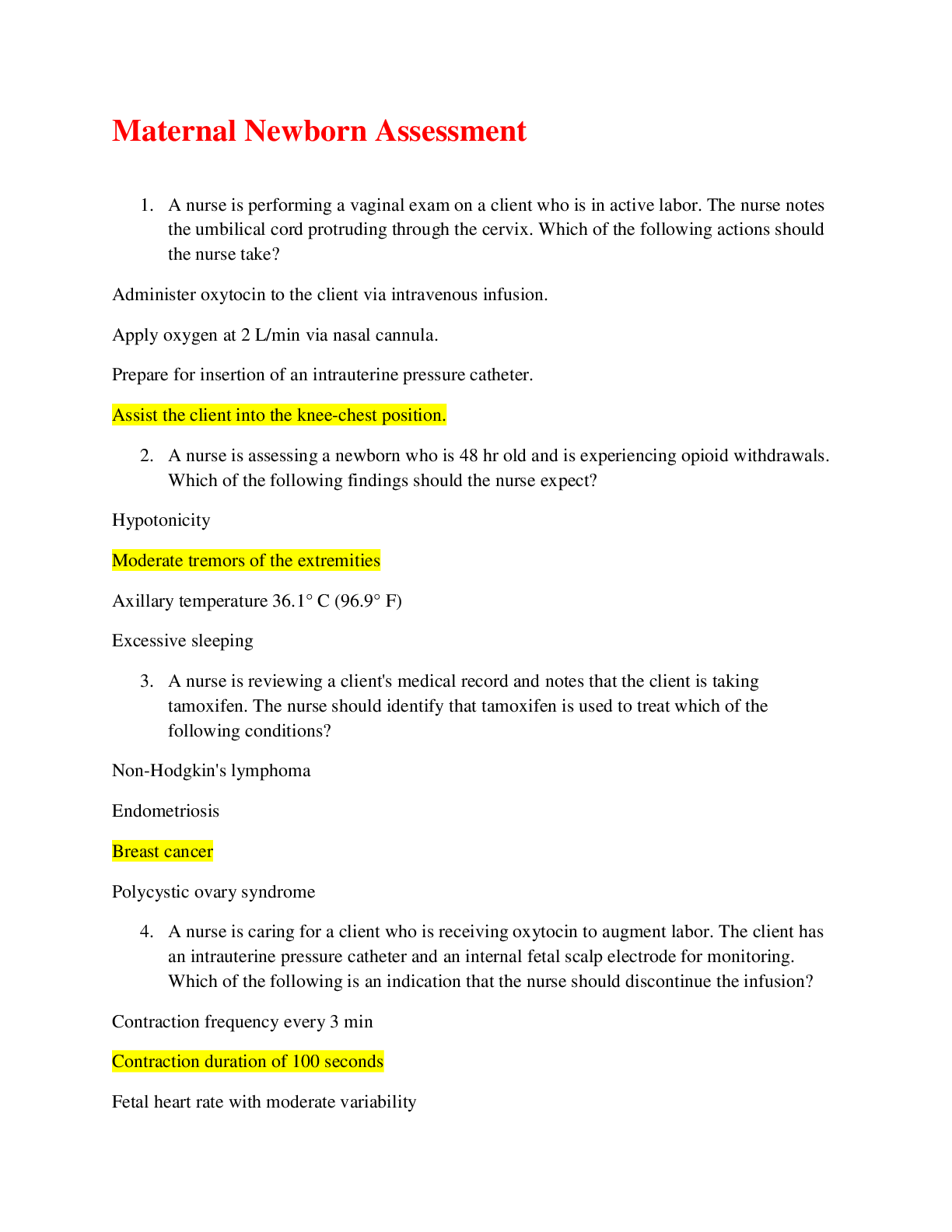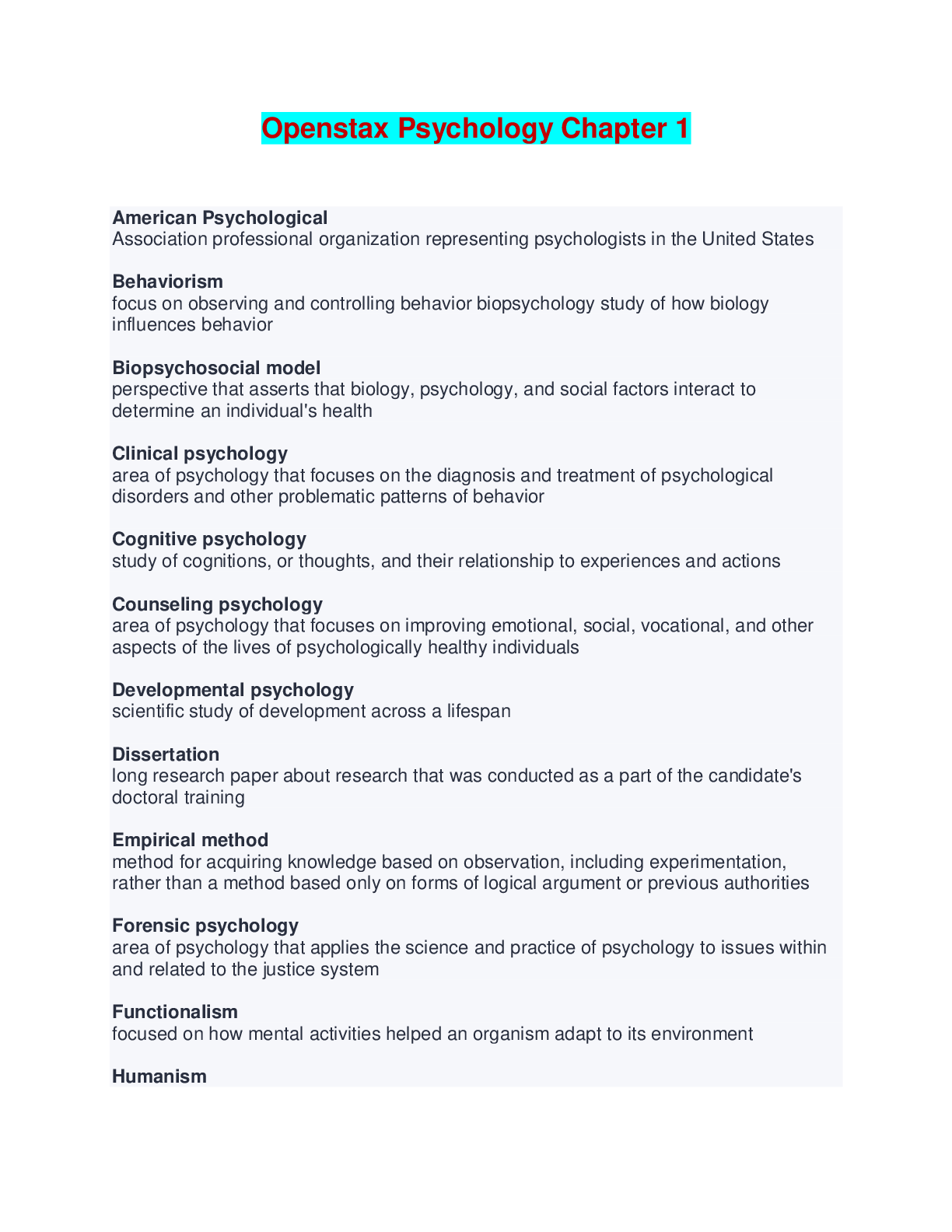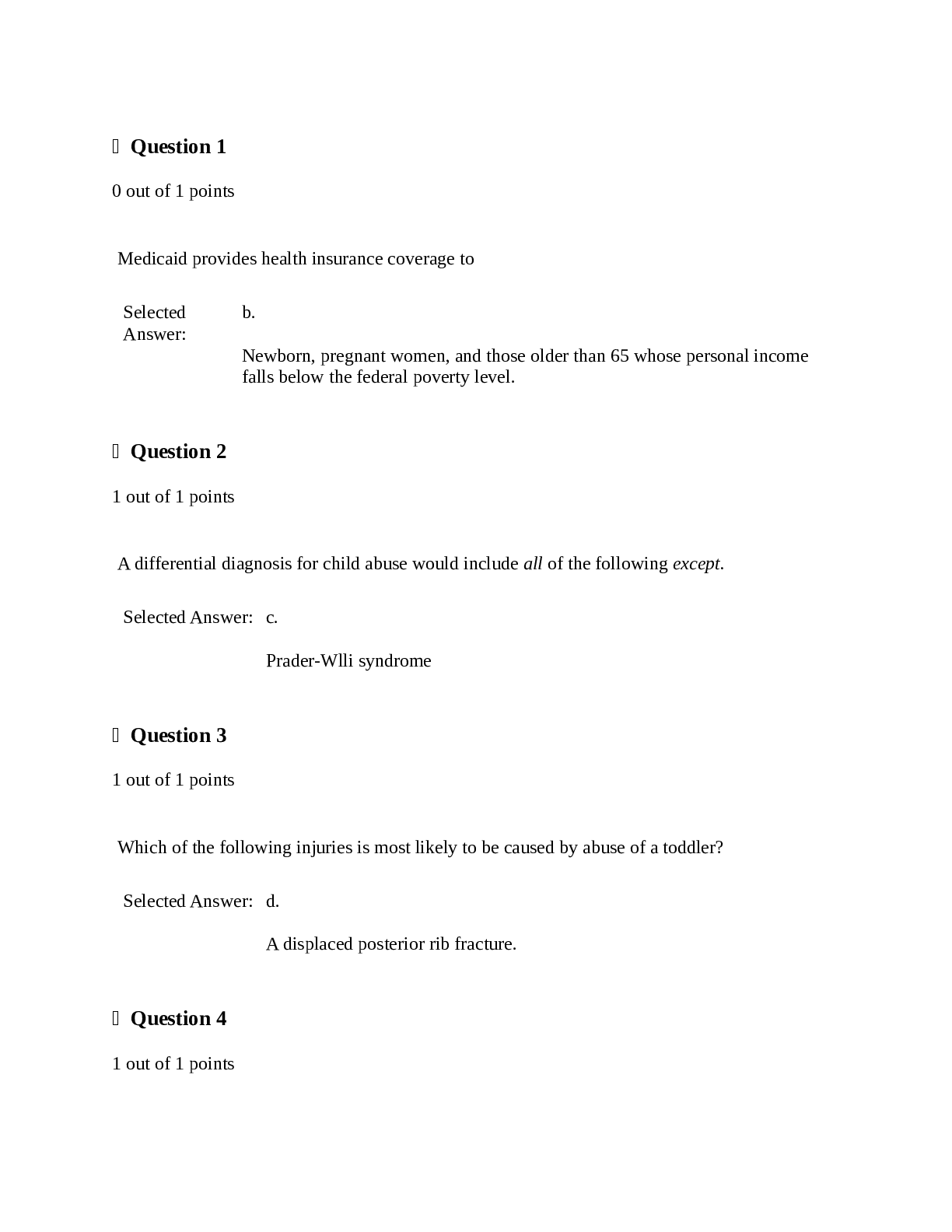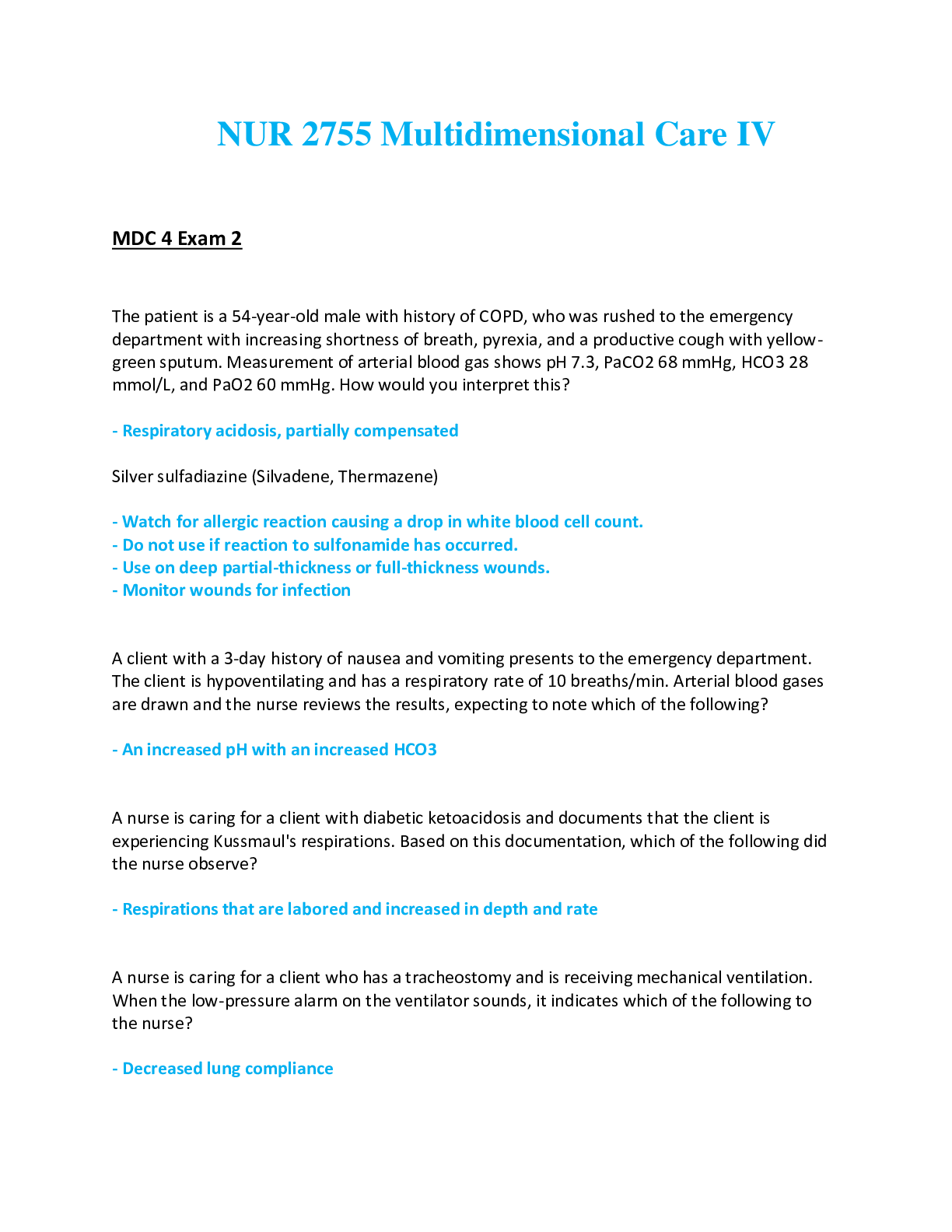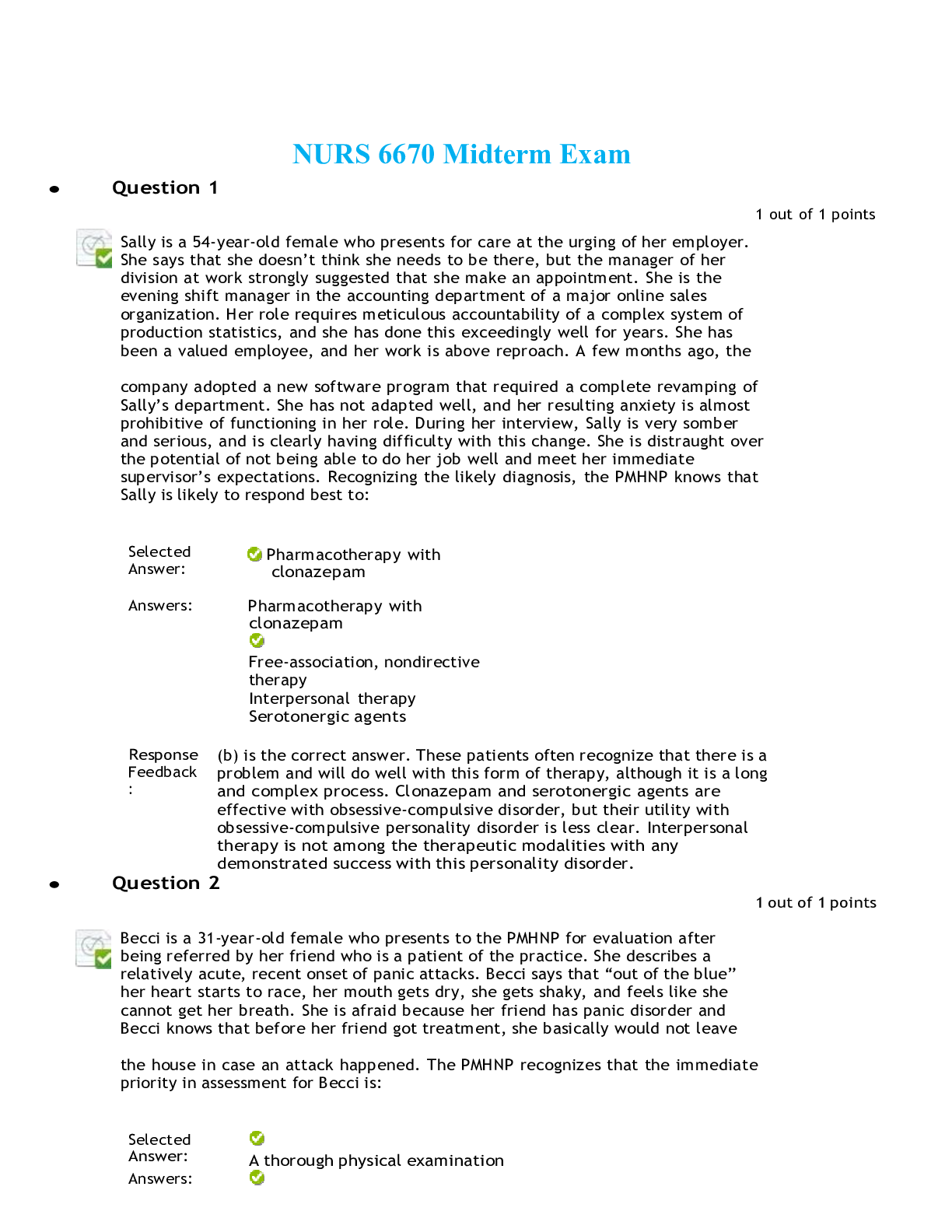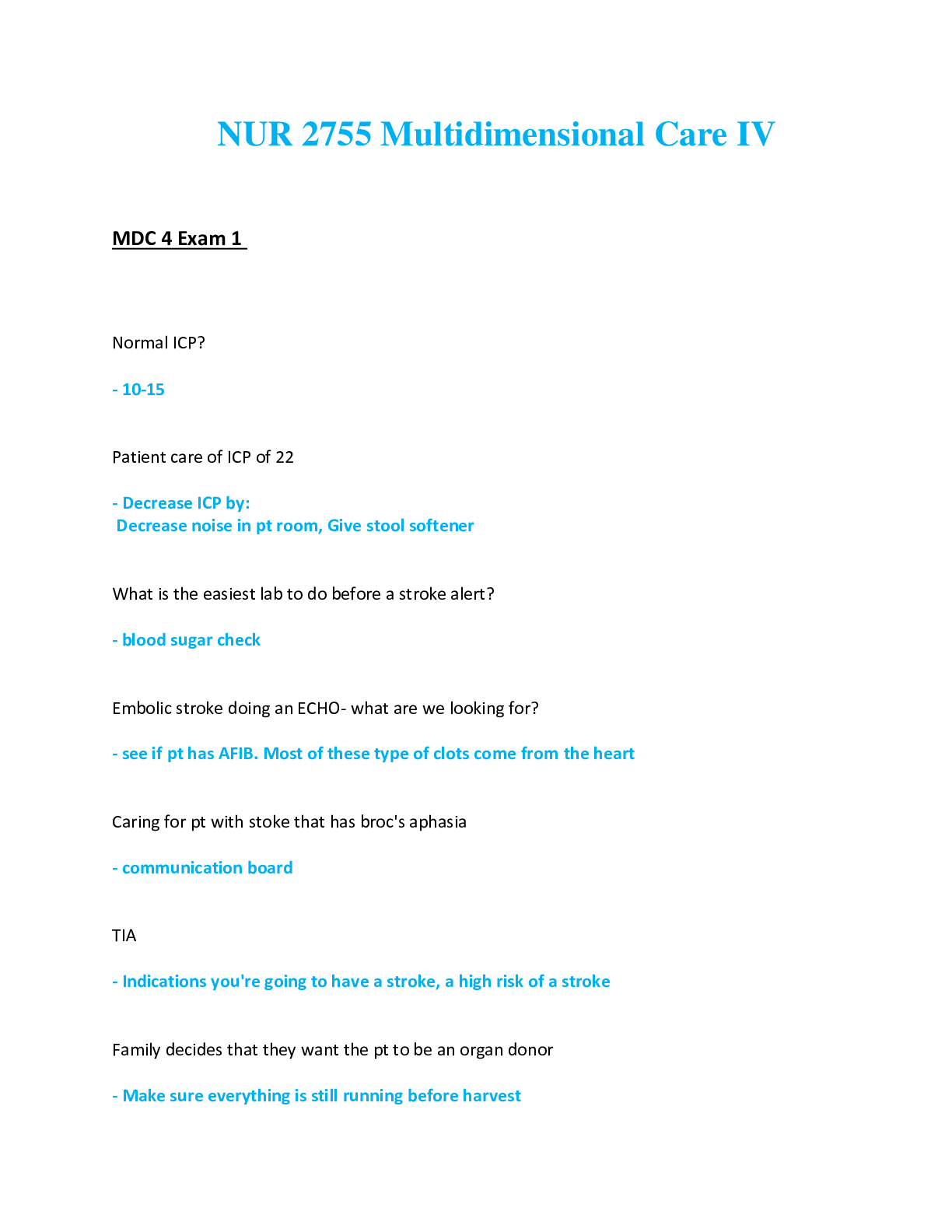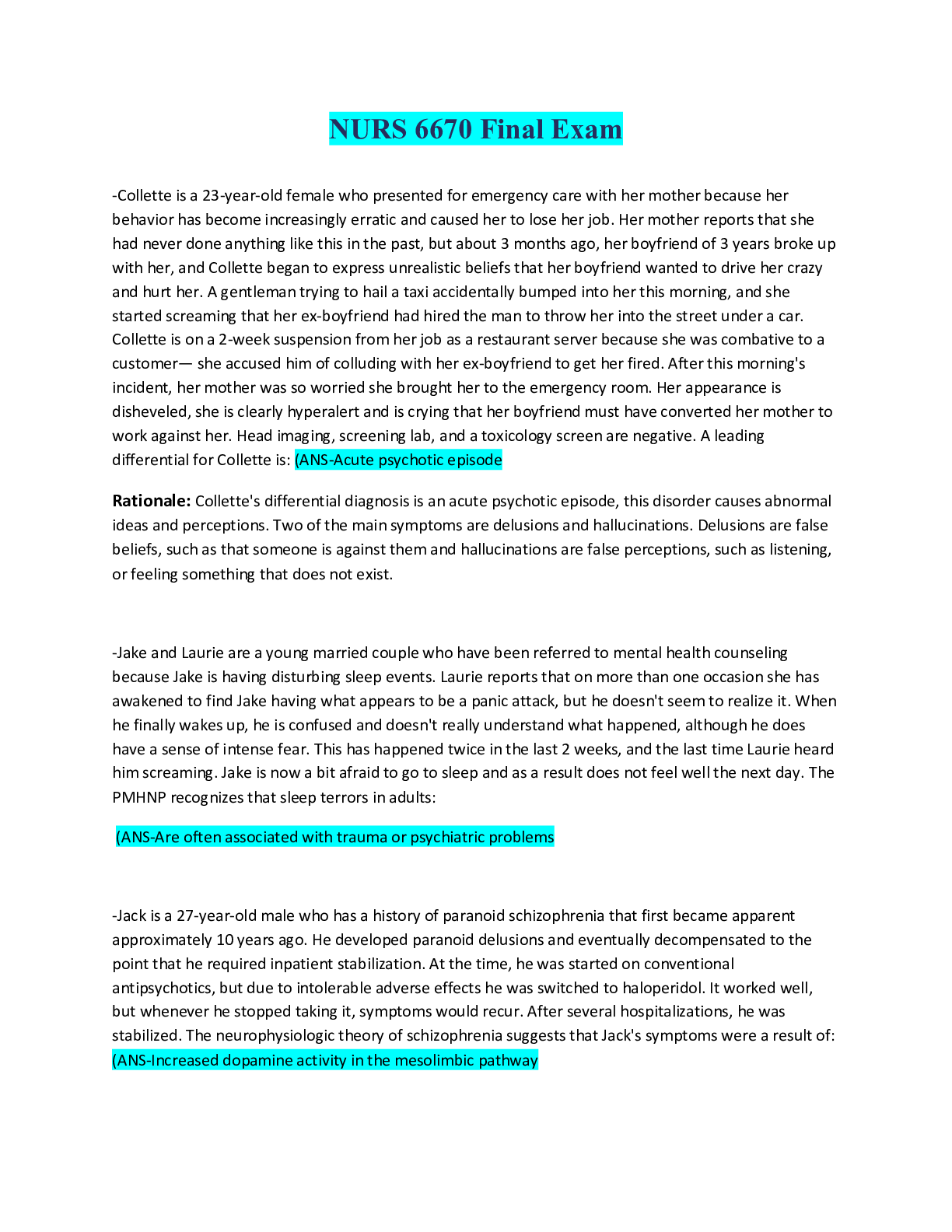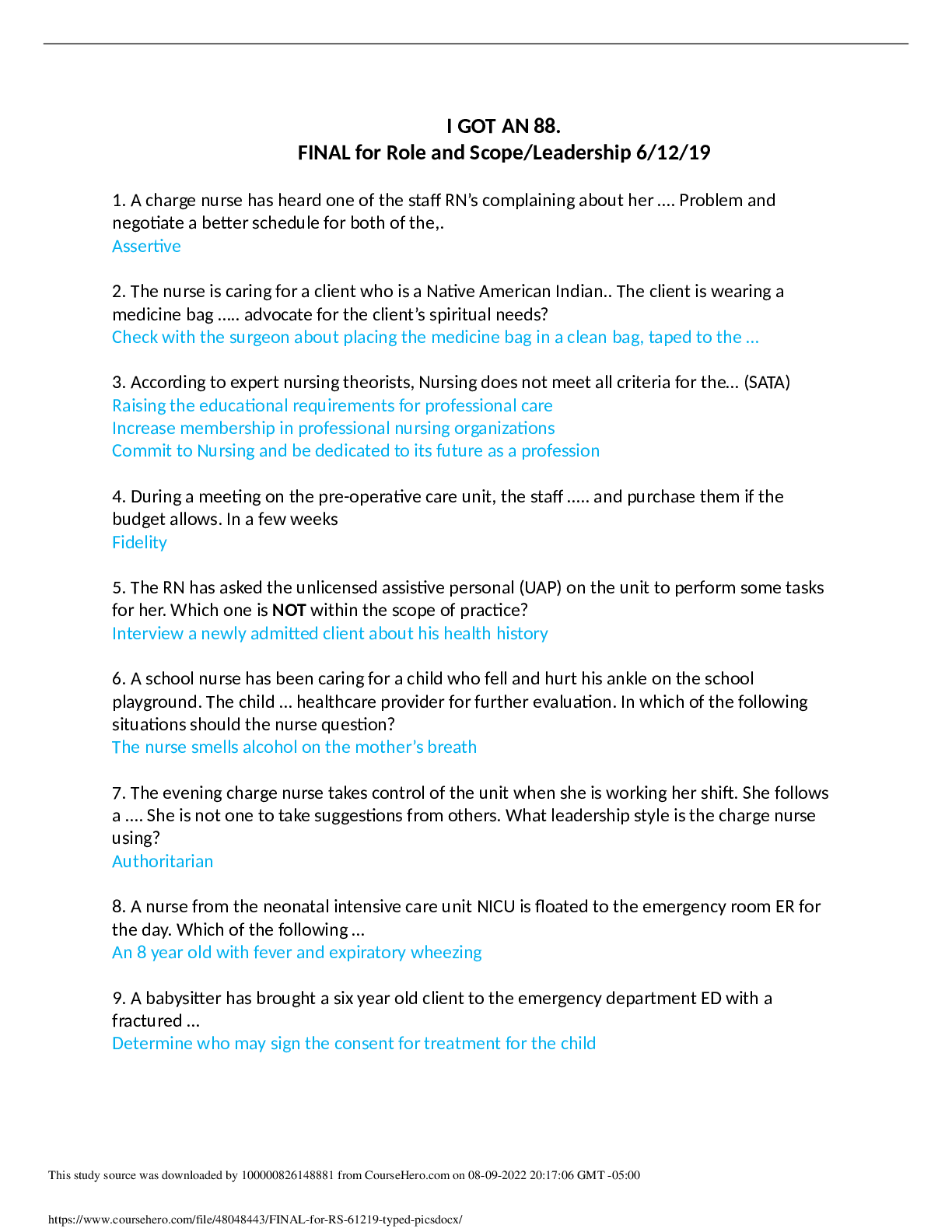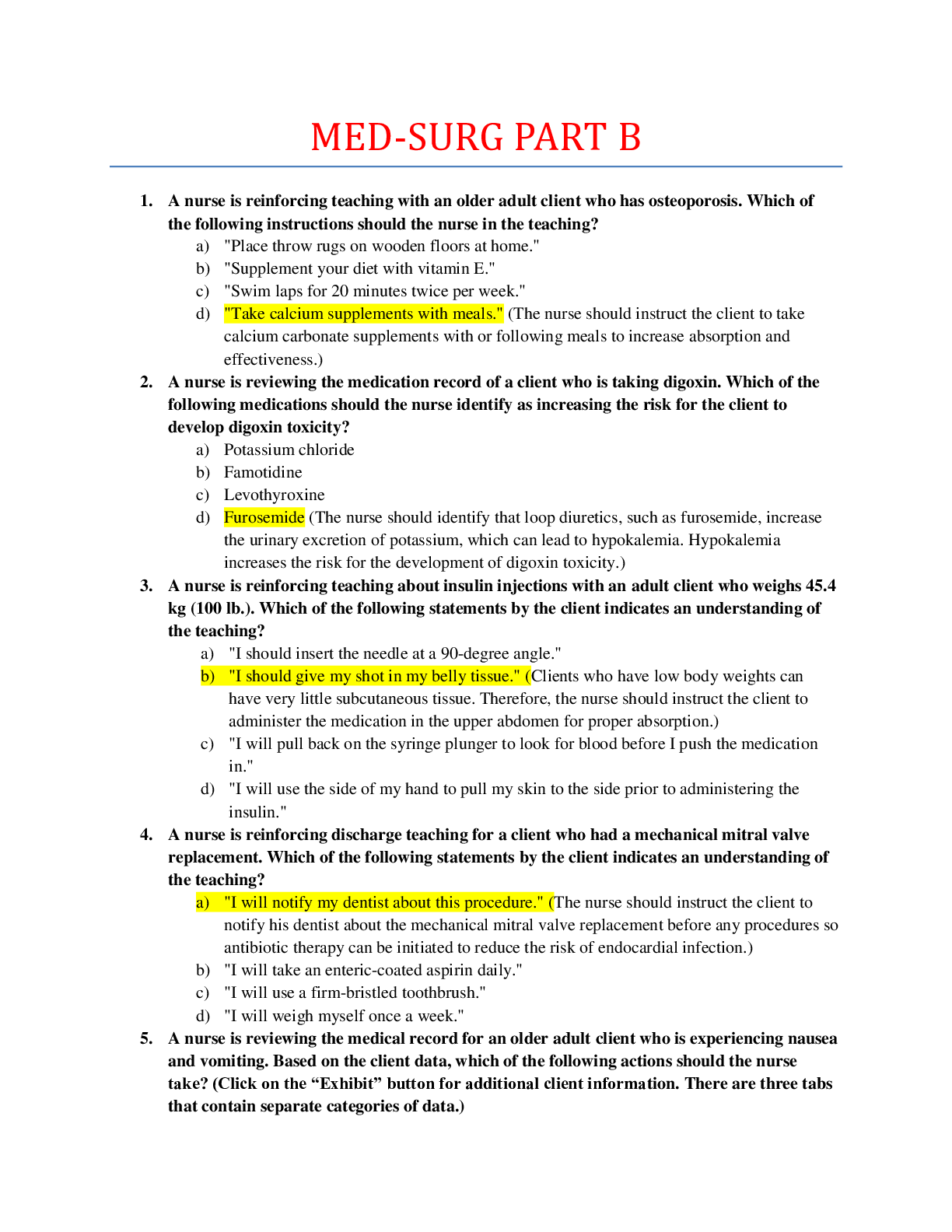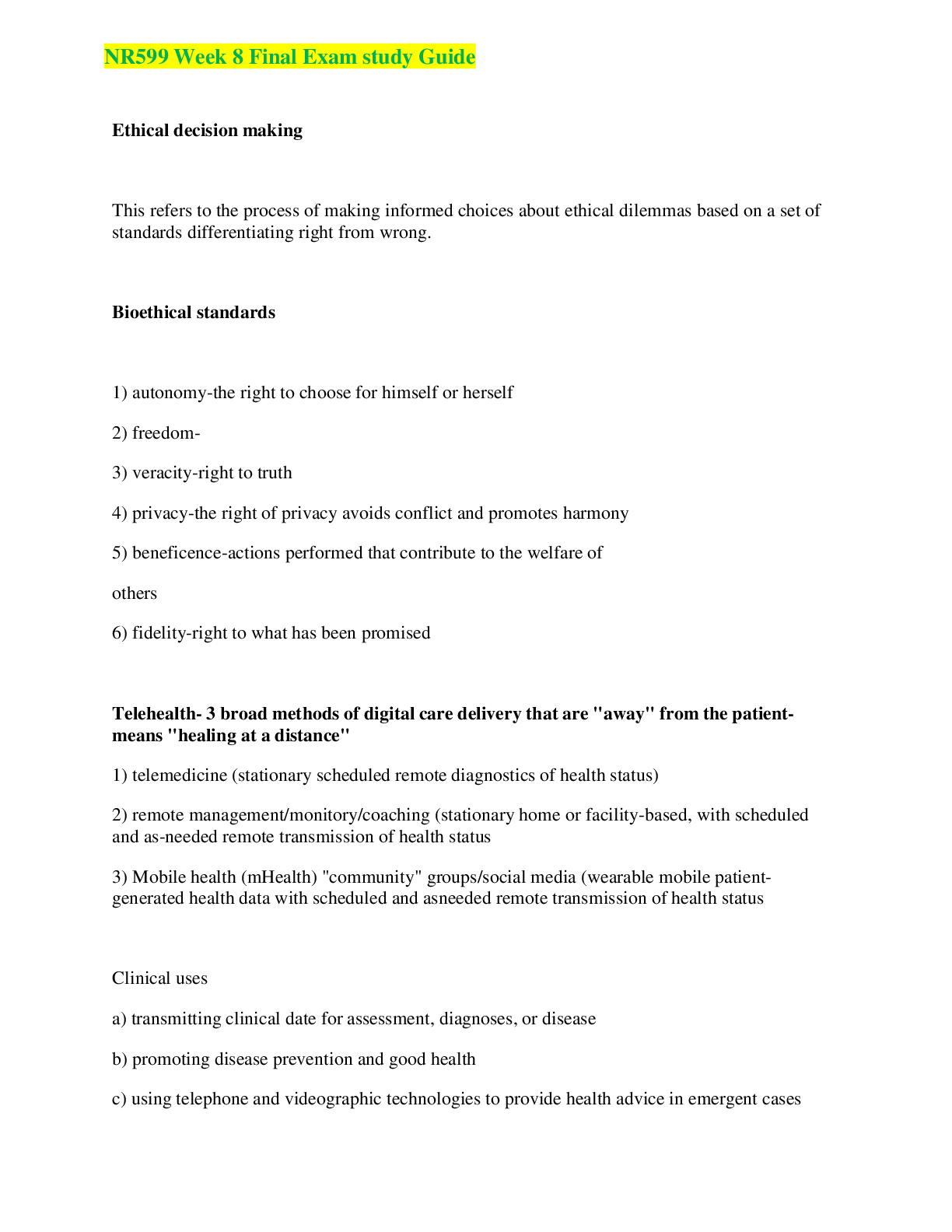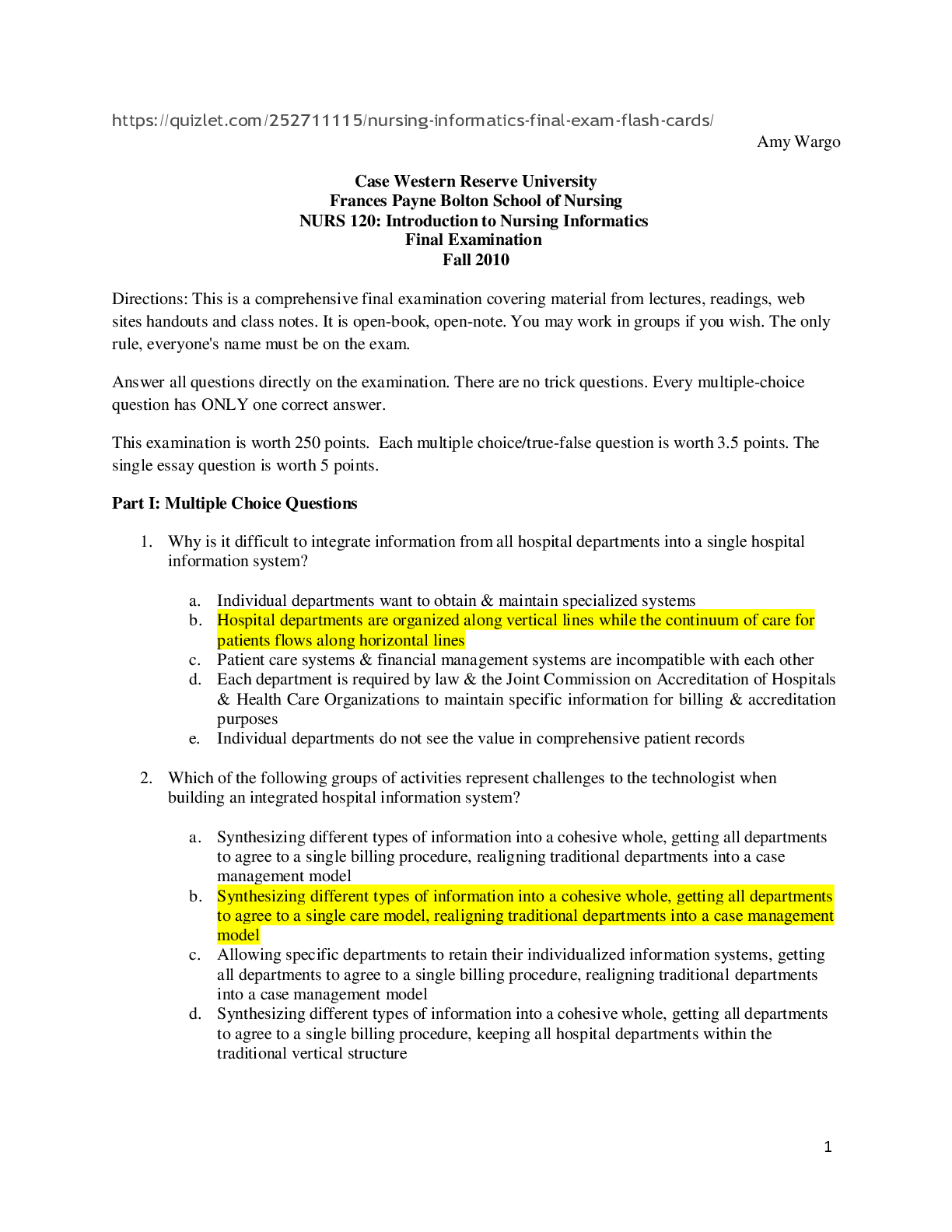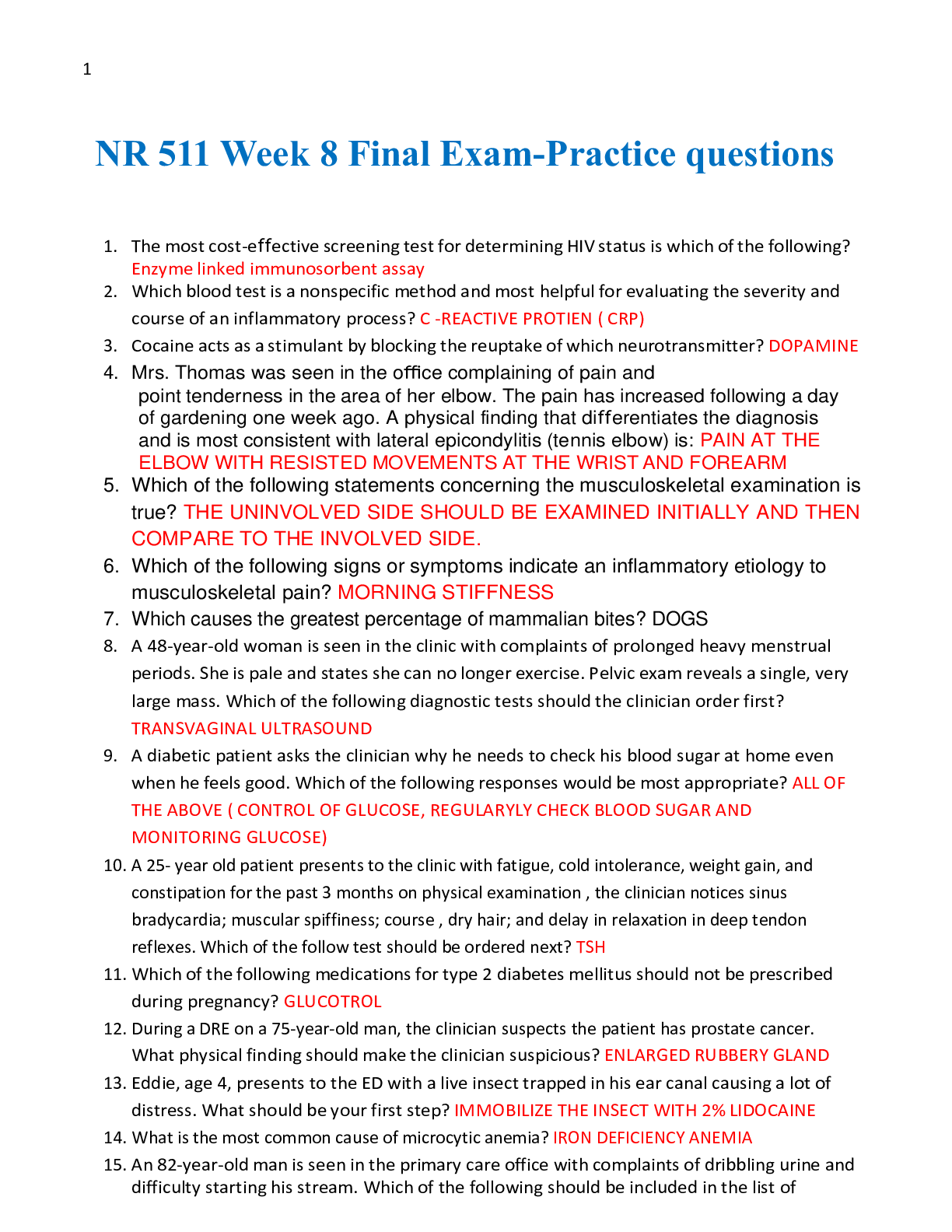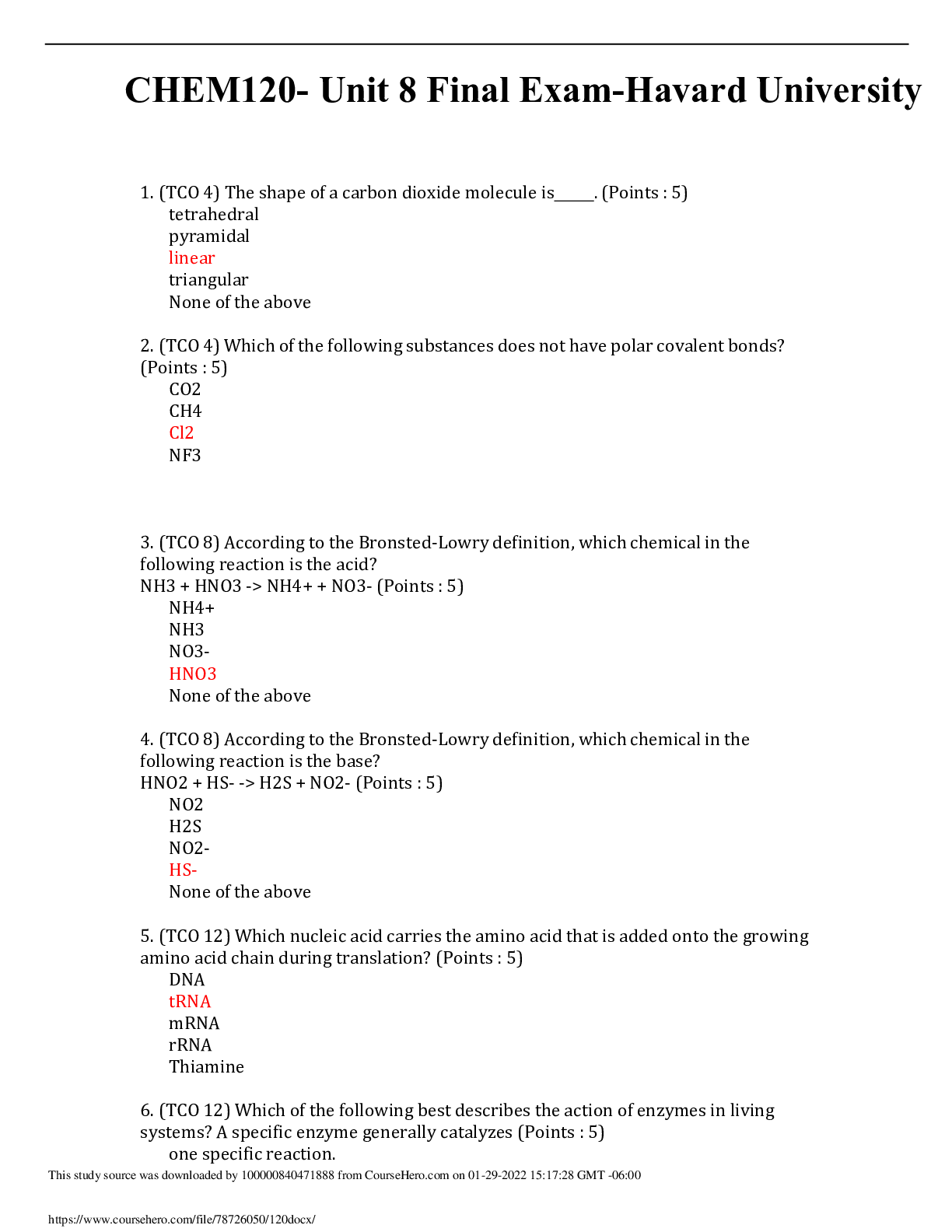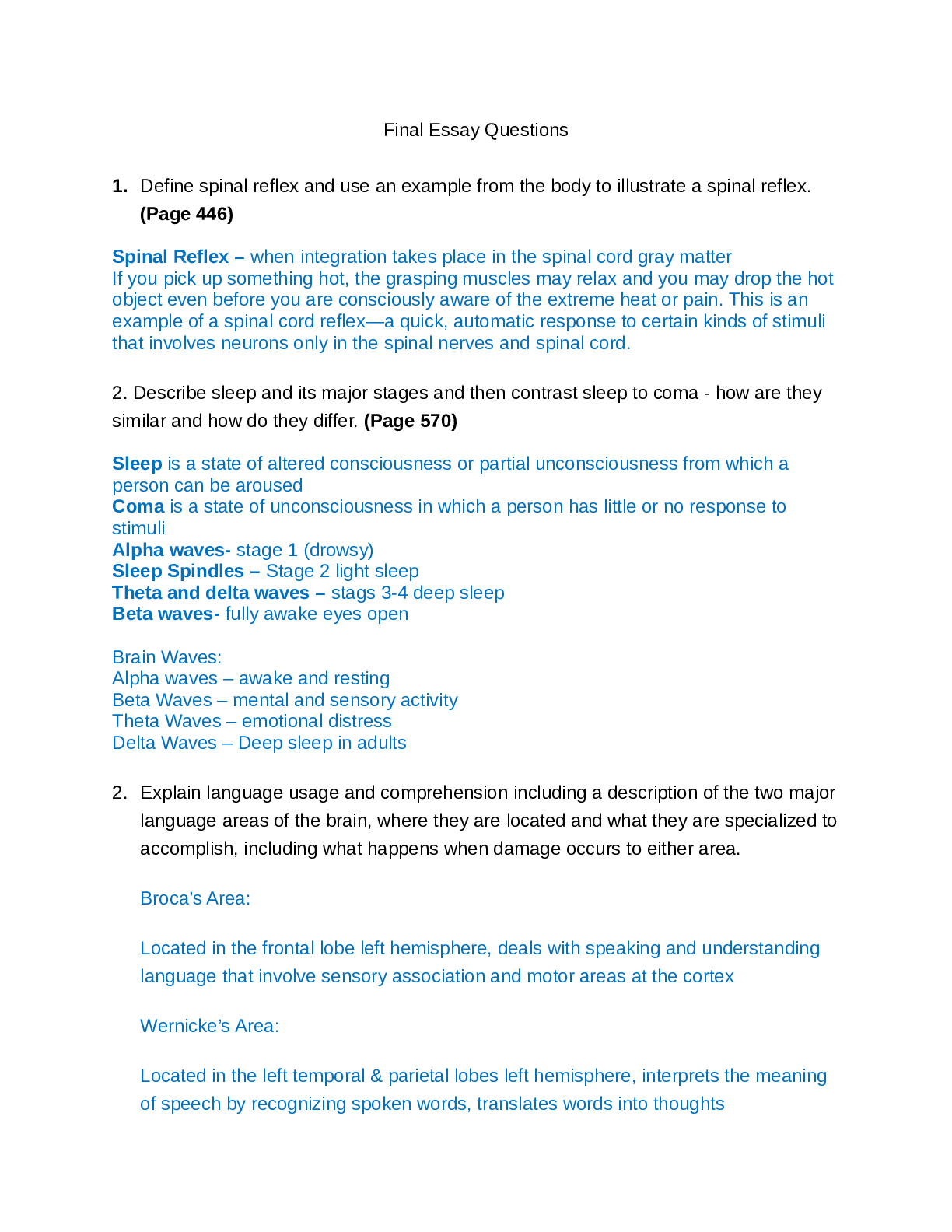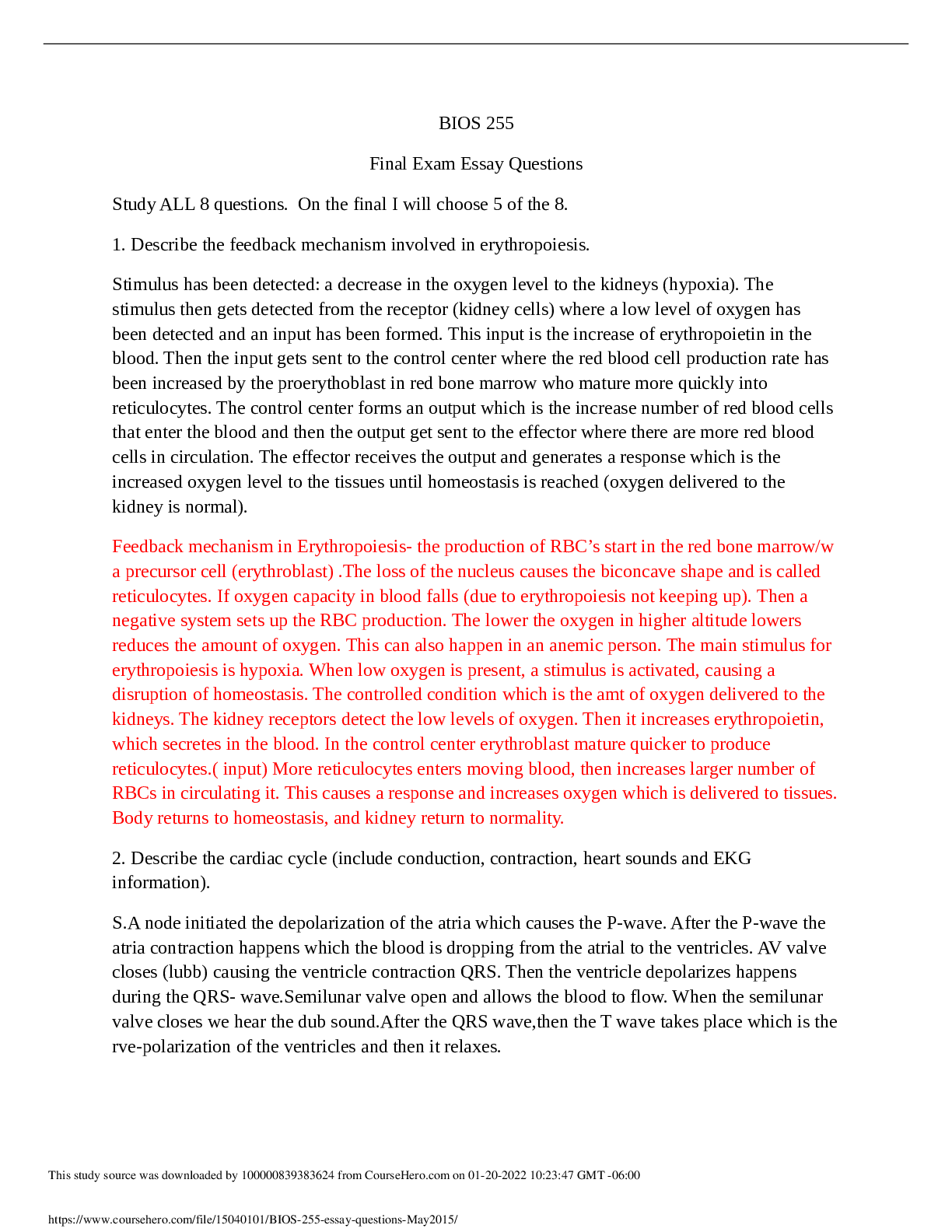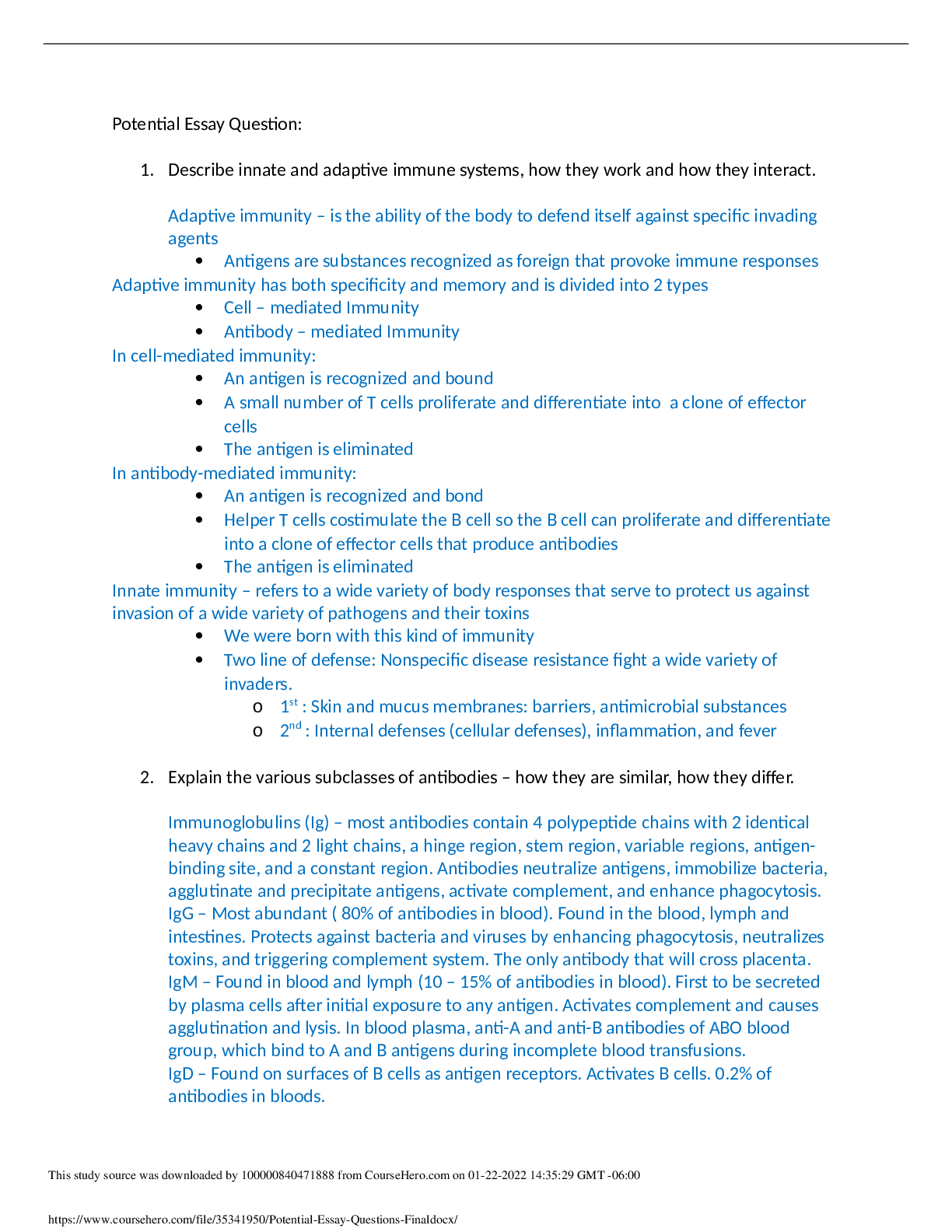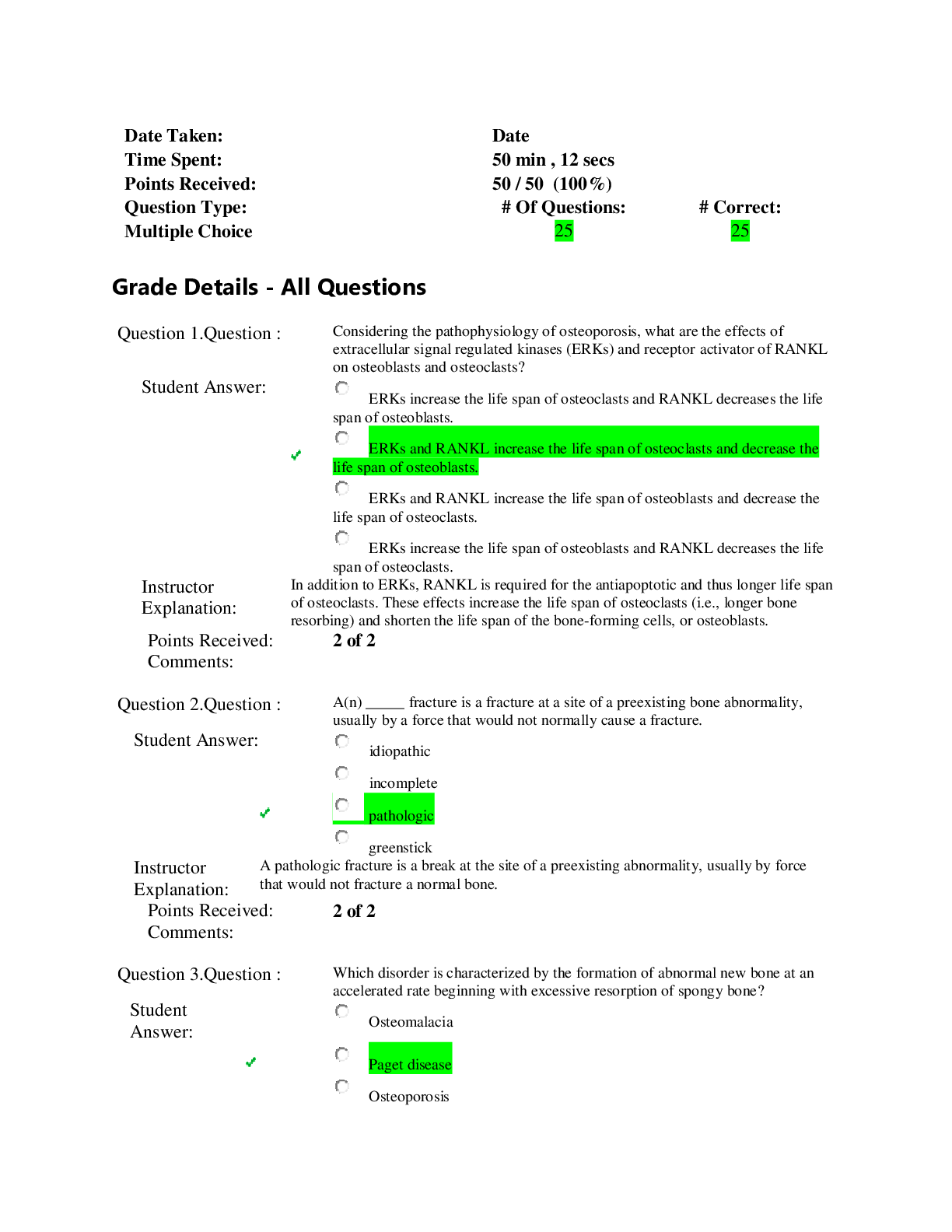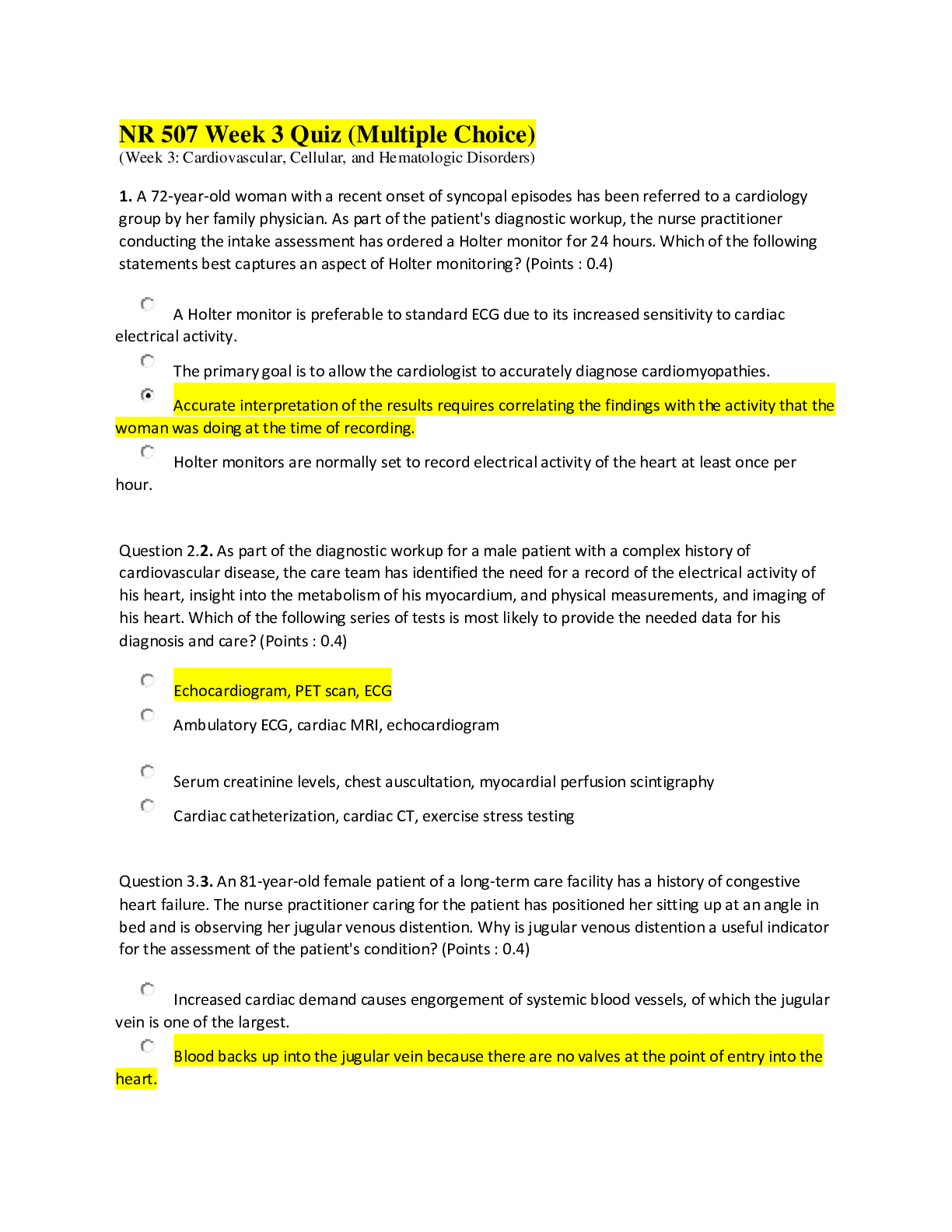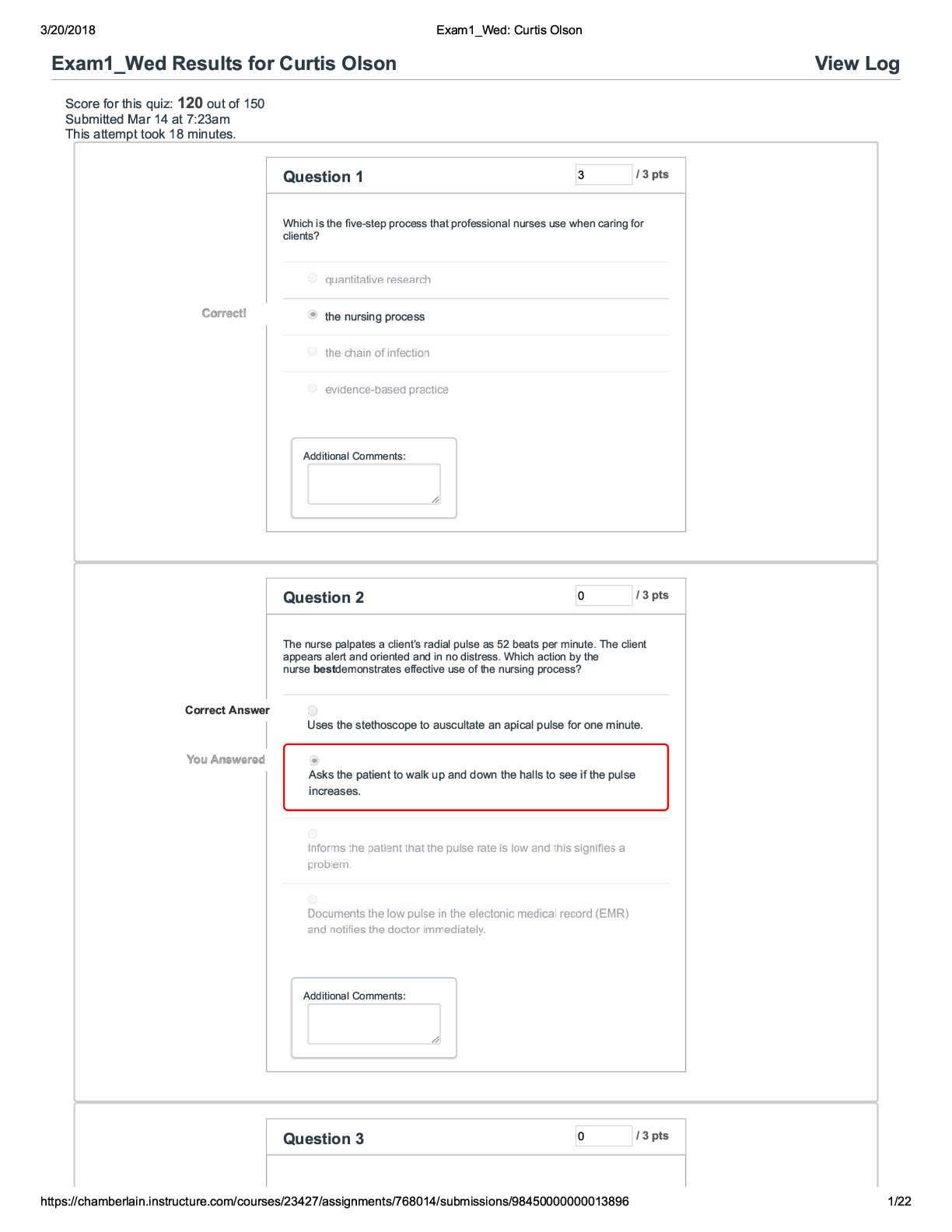*NURSING > EXAM > Chamberlain College of Nursing - RELI 448N Week 8 Final Exam (Version 1) Questions and Answers (All)
Chamberlain College of Nursing - RELI 448N Week 8 Final Exam (Version 1) Questions and Answers
Document Content and Description Below
RELI 448N Final Exam Question 1. 1. (TCO 1) A common element often found in religions is: (Pts: 4) respect for sculpture. feelings of wonder. rules governing meditat... ion. use of permanent places of worship. Question 2. 2. (TCO 1) The position that argues that we cannot know whether there is a god or not is known as: (Pts: 4) monotheism. polytheism. atheism. agnosticism. Question 3. 3. (TCO 2) Who was the founder of psychoanalysis, who theorized that belief in a God or gods arose from an adult's projection of powerful & long-lasting childhood experiences with his or her parents? (Pts: 4) Rudolf Otto James Frazer William James Sigmund Freud Question 4. 4. (TCO 4) Who was the French sociologist who argued that religious behavior is relative to the society in which it is found & that a society will use a religion to reinforce its own values? (Pts: 4) William James Wilhelm Schmidt Carl Gustav Jung Emile Durkheim Question 5. 5. (TCO 4) Name the American psychologist who viewed religion as positive way of fulfilling needs & praised its positive influence on the lives of individuals. (Pts: 4) James Frazer Carl Gustav Jung E.B. Tylor William James Question 6. 6. (TCO 8) One feature that probably contributed to the rich developments in Hinduism was which of the following? (Pts: 4) the constant invasions of India by foreigners the frequent floods & fires across India India's isolation from other areas India's extensive natural resources Question 7. 7. (TCO 8) The term meaning non-harm or nonviolence is: (Pts: 4) moksha. guru. ahimsa. maya. Question 8. 8. (TCO 9) Hinduism, as formulated in the Upanishads, (Pts: 4) encourages meditation to underst& the essence of reality. says we must honor our social obligations & roles. rejected the authority of the Vedas in formulating new religious insights. advocates devotion to any of the many gods. Question 9. 9. (TCO 10) The most accurate descriptor of Jainism is: (Pts: 4) polytheistic. monotheistic. atheistic. nontheistic. Question 10. 10. (TCO 8) The Buddha's first disciples were: (Pts: 4) his wife & child. his five former ascetic companions. the great king Ashoka. members of the warrior-noble class. Question 11. 11. (TCO 8) Once a person reaches nirvana: (Pts: 4) suffering continues only for this life. samsara is attained. rebirth is finished. the Pure L& is entered. Question 12. 12. (TCO 8) By his teachings, Confucius hoped to: (Pts: 4) counter the influx of Buddhism into China. produce virtuous people & create a harmonious society. make a break with the past & focus China on the future. draw people closer to Tian (Heaven). Question 13. 13. (TCO 8) Confucius thought the most important relationship was: (Pts: 4) ruler-subject. husband-wife. father-son. friend-friend. Question 14. 14. (TCO 9) Which is not a Daoist value? (Pts: 4) Simplicity Spontaneity Sensing movements of nature Formal education Question 15. 15. (TCO 9) In Zhuangzi's (Chuang Tzu's) famous dream, he was not certain that he was not: (Pts: 4) Confucius. an ox. a butterfly. a Daoist. Question 16. 16. (TCO 5) All of the following ancient world religions are minor religions except: (Pts: 4) Shinto. Buddhism. Taoism. Jainism. Question 17. 17. (TCO 11) Sikhism is charaterized by: (Pts: 4) special clothing & religious militarism. special clothing but not religious militarism. religious militarism but not special clothing. special clothing only. Question 18. 18. (TCO 6) A contract between the Hebrews & their God was called a: (Pts: 4) mitzvah. covenant. yarmulke. commandment. Question 19. 19. (TCO 6) The first King of Israel was: (Pts: 4) Daniel. Moses. David. Saul. Question 20. 20. (TCO 6) God first appeared to Moses in: (Pts: 4) an Egyptian slave. a cloud on Mt. Sinai. a burning bush. the Red Sea. Question 21. 21. (TCO 7) The view that God's imminent divine judgment & the end of the world is near is: (Pts: 4) messianism. apocalypticism. redemption. schism. Question 22. 22. (TCO 7) The most Jewish of the Gospels is: (Pts: 4) Matthew. Mark. Luke. John. Question 23. 23. (TCO 6) Like Judaism, Islam forbids: (Pts: 4) eating unleavened bread. wearing of veils by women. eating pork. wearing gold jewelry. Question 24. 24. (TCO 6) The Sunni & Shiite branches of Islam split over a dispute about: (Pts: 4) whether or not to have a lunar calendar. how many wives were acceptable. succession after Muhammad. when the pilgrimage should be performed. Question 25. 25. (TCO 12) Established groups of Wiccans are called: (Pts: 4) witches. sisterhoods. covens. sects. 1. (TCO 4) Compare & contrast a psychological view of religion (Freud, Jung, or James) with a sociological point of view (Durkheim or Levi-Strauss). Defend one of the two theories you selected as a better explanation for the origin of religions. (Pts: 50) Sigmund Freud believed that the impact that our childhood, as well as the experiences that we encountered in our formative years is what shaped our religious belief system today. The religious beliefs that our parents have & imprint on us are ultimately the main factor for whatever belief system we find ourselves in. He also went a step further to say, the issues that we encounter in life as adults is managed by our religion. We use the answers we learned from our religion to answer the questions that we encounter as adults. By doing this it further reinforces our image of God in our children. Only by being more educated & having a better security about the world we live in do we lose the insecurity & the need for religion. Emile Durkheim believed that religion was a social or group event & that not just one person would conjure it. These groups had structure & rules to them like a small society, & this small group was able to use its influence to shape its needs in the society it existed in. He did not just rely on the faith that religion provides or the speculation of philosophers, he examined the evidence regarding religion & based his conclusions on that. Although Freud’s conclusions can be considered speculative there is truth to the fact that we do tend to gravitate to the religion of our parents or upbringing. The exposure to religions at a young age by the society we live in is exactly what Durkheim was talking about when he said society creates the religion. If we live in society & have parents of a particular religion it can be inferred by both philosophers & phycologists that we will be shaped by those religious beliefs as well as contribute to the religion itself by the growing members of it in our society. 2 Identify & analyze the Four Noble Truths, in particular, the Noble Eightfold Path. What ideas from Hinduism did Buddhism essentially keep? Describe them. Include enough details to support your answer. The First Noble Truth States that “to live is suffering.” This means that throughout our lives we will experience numerous types of pain; from childbirth, to adolescent, we will be hurt physically, experience depression, sorrow, loss, & physical pain. Therefore al of life is a painful beginning to a long journey The Second Noble Truth states “Suffering comes from desire.” There are many wants that we will experience in our live that will cause us grief. Wanting better clothes & devices & houses & cars can all cause grief for things we cannot have or do not have yet. Alcoholism & gluttony are also part of this stage where the desire for both cause suffering for us & our families. The Third Noble truth states “to end suffering end desire.” This is not a call to commit suicide, rather accept what we cannot change.. It is reminiscent of the serenity prayer where we ask God for strength to accept the things we cannot change & the courage to change the things we can & the wisdom to know the difference. Remove the wants we have in this life all the attachments & desires are what bring us back into the cycle of the second noble truth. The Fourth Noble truth states we can only experience a release from this suffering by following the noble eightfold path. The Noble eightfold path is also known as the way to inner peace. 1. Right Understanding 2. Right intention 3. Right Speech 4. Right Action 5. Right Work 6. Right Effort 7. Right Meditation 8. Right Contemplation Many of the traditions in Buddhism are directly from Hinduism teaching. Siddhartha Gautama, is considered the founder of Buddhism, he was also follower of Hinduism. One of the main difference is that Hindu is a religion & the worship of the gods are part of being Hindu. While being a Buddhist does not require the worship of particular gods, rather it focuses on being a righteous person & living mindful 3. (TCO 3) Explain & evaluate Paley's Teleological Argument for the Existence of God: In crossing a heath, suppose I pitched my foot against a stone & were asked how the stone came to be there, I might possibly answer that for anything I knew to the contrary it had lain there forever; nor would it, perhaps, be very easy to show the absurdity of this answer. But suppose I had found a watch upon the ground, & it should be inquired how the watch happened to be in that place, I should hardly think of the answer which I had before given, that for anything I knew the watch might have always been there. Yet why should not this answer serve for the watch as well as for the stone? Why is it not as admissible in the second case as in the first? For this reason, & for no other, namely, that when we come to inspect the watch, we perceive--what we could not discover in the stone--that its several parts are framed & put together for a purpose, e.g., that they are so formed & adjusted as to produce motion, & that motion so regulated as to point out the hour of the day; that if the different parts had been differently shaped from what they are, of a different size from what they are, or placed after any other manner or in any other order than that in which they are placed, either no motion at all would have been carried on in the machine, or none which would have answered the use that is now served by it. To reckon up a few of the plainest of these parts & of their offices, all tending to one result; we see a cylindrical box containing a coiled elastic spring, which, by its endeavor to relax itself, turns round the box. We next observe a flexible chain--artificially wrought for the sake of flexure--communicating the action of the spring from the box to the fusee. We then find a series of wheels, the teeth of which catch in & apply to each other, conducting the motion from the fusee to the balance & from the balance to the pointer, & at the same time, by the size & shape of those wheels, so regulating that motion as to terminate in causing an index, by an equable & measured progression, to pass over a given space in a given time. We take notice that the wheels are made of brass, in order to keep them from rust; the springs of steel, no other metal being so elastic; that over the face of the watch there is placed a glass, a material employed in no other part of the work, but in the room of which, if there had been any other than a transparent substance, the hour could not be seen without opening the case. This mechanism being observed--it requires indeed an examination of the instrument, & perhaps some previous knowledge of the subject, to perceive & underst& it; but being once, as we have said, observed & understood--the inference we think is inevitable, that the watch must have had a maker-that there must have existed, at some time & at some place or other, an artificer or artificers who formed it for the purpose which we find it actually to answer..." Paley then argues that if a watch presumes there is a watchmaker then the existence of the universe must point to a God, who made the universe just as the watchmaker made the watch. Briefly explain & then evaluate this proof for the existence of God. This Teleogical argument is a conundrum. It states that if something as intricate as a watch has a creator so there must be a creator for life itself. To delve further into it, the watch has many moving parts & we would never suspect that it just so happened to be that way. Even if you take the components apart you would still see that there is definitive proof that the elements alone are also intricate. So with a working knowledge of the world we could not just assume that the things in life are just here because they came to be this way & this is how they are. The case for this argument is also used in the human eye, there are so many facets to the human eye that st& to reason there must be a creator, surely we didn’t just arrive at an eye this intricate. There must be some gr& designer of this eye, & if there is a designer of the human eye, so there is also a designer of the universe & all its complex parts as well. 4. (TCO 11) Identify & analyze three basic patterns in indigenous religions. Use examples from traditional Hawaiian religion to support your answer. One pattern of indigenous religions is the word of mouth or oral representation of the religion. This is done by generations of a particular group talking practicing & or chanting their religious beliefs. For Hawaii their religions was largely influences by the Polynesian isl& & their settlers traversing the Pacific Ocean. Their ability to navigate the ocean was how they were able to spread their religious beliefs in that part of the world. This ultimately affected Hawaii culture. Their gods were similar in nature to the native Indians who worshiped the earth & believed in nature. Hawaiians believe in the gods of sky & earth called Wakea who had a female companion Papa. Language also plays an important part of an indigenous religion. Although Hawaii had their own set of beliefs & language, when western culture arrived it shaped the culture & religion in a different way. There still remains a very deeply rooted part of every indigenous religion in Hawaii but it has evolved into a largely Christian religious state. This is because of the written words that the western Christians brought with them that changed & adapted itself to Hawaiian culture. One particular example of how the westerners shaped the religion is the arrival of James Cook. Ku & Lono were two gods that were often invoked & worshiped. Ku was the god of virtue & war he was invoked for things like fishing & digging & ultimately fighting. On the flip side you had Lono who was the god of peace, fertility & love. In the winter was when this god was worshiped because of the Pleiades or the seven sister stars would appear in the sky. This happened in October & November & was given a name called Makahiki. The practices revolved around this worship used a banner with a bird symbol on the top. This is reflective of Captain Hook & his ships flag that arrived during the same season. This ultimately affected dhow the religious practices have evolved on an isl& cut off from much of the world & retained much of its culture & still was affected by western influences [Show More]
Last updated: 1 year ago
Preview 1 out of 10 pages
.png)
Reviews( 0 )
Document information
Connected school, study & course
About the document
Uploaded On
Nov 10, 2020
Number of pages
10
Written in
Additional information
This document has been written for:
Uploaded
Nov 10, 2020
Downloads
0
Views
55



